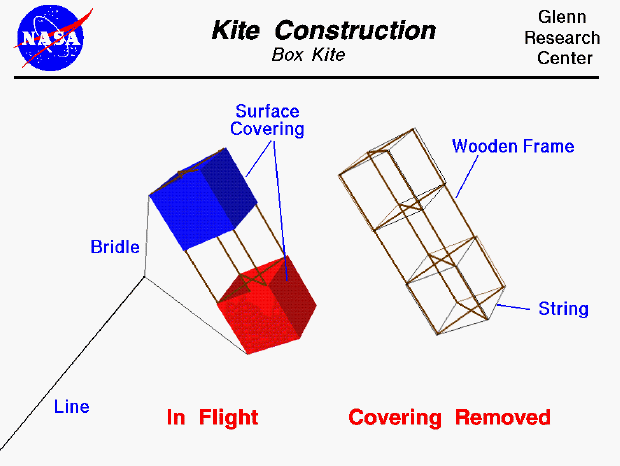

An excellent way for students to gain a feel for aerodynamic forces is to fly a kite. Kite flying is fun when done safely and you can learn many of the fundamentals of airplane aerodynamics because a kite is very much like an airplane. In fact, the Wright brothers used kites and gliders to learn the fundamentals before their first successful airplane flight.
Like an airplane, a kite is a heavier than air craft. Kites depend on surfaces to generate the aerodynamic forces necessary for flight and use rigid structures to support the surfaces and transmit the forces. Different kites. have different types of surfaces and structures; on this slide we show a simple box kite. The left side of the figure shows the kite as it would appear in flight and the right side shows the inner structure.
Kite flying is a delicate balance between aerodynamic forces, the weight of the parts of the kite, and the distribution of these forces. In flight, the kite is connected to the flyer by the control line and the flyer can feel the tension in the line created by the aerodynamic forces on the kite. The line is connected to the kite by a string bridle. The place where the bridle connects to the line is called the bridle point and the kite pivots about this point in flight. The bridle point can be adjusted to change the flight characteristics of the kite. The surfaces of the kite are covered by a thin covering of paper, plastic, or cloth, which deflects the wind downward and creates the aerodynamic forces of lift and drag on the kite.
If we remove the covering, we can see the structure which transmits the aerodynamic forces to the bridle. A box kite structure is made from several sticks and some string. The sticks can be made of a light but strong piece of wood such as balsa or bamboo, or a light but strong plastic tube. In the box kite, there are four main "leg" pieces of equal length and four "cross" pieces which are made from two sticks. The structure is held together with strings wrapped around the legs at the location of the cross members. The surface covering is attached to the strings. Notice that the structure is small, light and strong. It must be made strong to withstand the forces of the wind and weight, but it must also be light to keep the weight low. To save weight, only two "cross" pieces are used on some box kites. The trade of strength and weight must be considered in every flying thing from a kite to a large airliner. Compare the structure and coverings of this box kite with the Wright brother's 1900 aircraft and note how similar they are.
Navigation..
Go to...
byTom
Benson
Please send suggestions/corrections to: benson@grc.nasa.gov